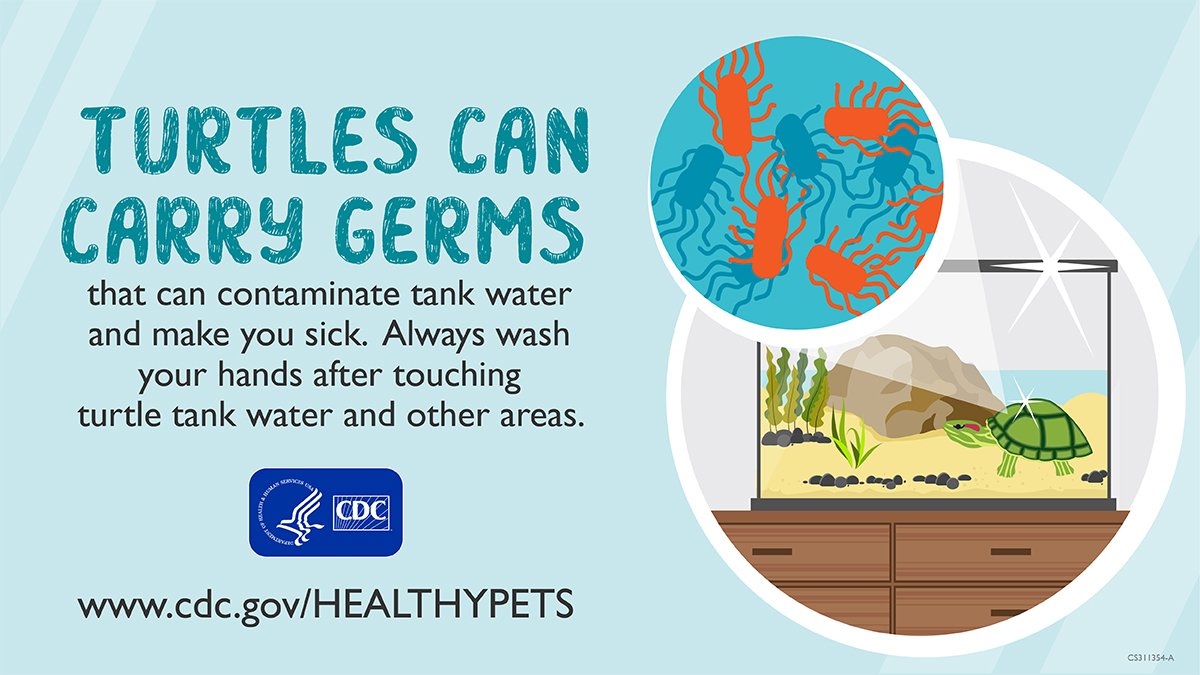What Disease Do Turtles Carry? Uncovering Health Risks
Turtles, fascinating creatures that gracefully swim through the depths of our oceans and lakes, may seem harmless and even endearing. However, have you ever wondered what diseases they might carry? Today, we will delve into the world of turtles, exploring the potential health risks they pose and the measures we can take to protect ourselves and these magnificent creatures. So, what disease does turtles carry? Let’s embark on this informative journey together and uncover the hidden truths that lie beneath the calm exterior of these ancient reptiles.
What Diseases Do Turtles Carry?
Turtles are fascinating creatures that have been roaming the Earth for millions of years. With their unique shells and serene demeanor, they have captured the curiosity and intrigue of humans. However, just like any other animal, turtles can carry diseases that may pose a risk to both their own health and humans who come into contact with them. In this article, we will explore various diseases that turtles carry, their symptoms, transmission methods, and preventive measures.
1. Salmonellosis
Salmonellosis is perhaps the most well-known disease associated with turtles. Salmonella bacteria naturally reside in the intestines of many animals, including turtles. While turtles may appear healthy, they can carry this harmful pathogen and shed it through their feces, contaminating their environment. Human infection can occur through direct contact or by touching surfaces or objects contaminated by turtle feces. Symptoms of salmonellosis in humans include diarrhea, fever, abdominal pain, and vomiting.
Prevention and Safety Measures:
To minimize the risk of contracting salmonellosis from turtles, it is essential to follow these safety guidelines:
- Always wash your hands thoroughly with soap and water after handling turtles or their habitat.
- Do not allow turtles to roam freely in areas where food is prepared or consumed.
- Supervise children when they are in contact with turtles and ensure proper hand hygiene afterward.
- Use designated equipment and containers solely for turtle care to avoid cross-contamination.
2. Fibropapillomatosis
Fibropapillomatosis is a viral disease commonly found in sea turtles, particularly green turtles. It is characterized by the development of benign tumors, known as fibropapillomas, on various parts of the turtle’s body. These tumors can grow internally or externally, potentially causing obstruction of vital organs or impeding the turtle’s ability to swim and feed. The exact cause of this disease is still unclear, but it is believed to be influenced by environmental factors.
Symptoms and Impact:
Common symptoms and effects of fibropapillomatosis in turtles include:
- Presence of cauliflower-like tumors on the skin, flippers, or internal organs.
- Difficulty swimming, diving, or feeding due to the tumors’ hindrance.
- Weakened immune system, making the turtles susceptible to other infections.
Prevention and Management:
Efforts to prevent and manage fibropapillomatosis include:
- Reducing pollution and maintaining a clean marine environment to minimize stress on turtles.
- Supporting organizations dedicated to researching and rehabilitating fibropapillomatosis-affected turtles.
- Participating in beach clean-ups to remove potential sources of pollution that can harm turtles.
3. Shell Rot
Shell rot, also known as ulcerative shell disease, is a condition that affects a turtle’s shell, leading to the deterioration of its structural integrity. This disease is primarily caused by bacterial or fungal infections that penetrate the shell, usually through injuries or cracks. Once the infection sets in, it can spread and cause significant damage.
Symptoms and Impact:
Signs that a turtle may have shell rot include:
- Softening of the shell.
- Discolored or pitted areas on the shell.
- Presence of foul odor emanating from the shell.
- Behavioral changes, such as decreased appetite or lethargy.
Treatment and Prevention:
Prompt treatment and preventive measures can help manage shell rot effectively:
- Consult a veterinarian for diagnosis and appropriate treatment.
- Regularly inspect your turtle’s shell for any signs of damage or infection.
- Provide a clean and stress-free environment to minimize the risk of shell injuries.
- Keep water sources clean and ensure proper filtration in turtle habitats.
4. Upper Respiratory Tract Infections
Turtles, especially those in captivity or with compromised immune systems, can suffer from upper respiratory tract infections. These infections are typically caused by various bacteria and can lead to symptoms similar to those experienced by humans, such as sneezing, nasal discharge, and wheezing.
Treatment and Prevention:
To prevent and manage upper respiratory tract infections in turtles:
- Monitor the temperature and humidity levels in the turtle’s environment.
- Ensure proper ventilation in the enclosure to prevent the buildup of respiratory irritants.
- Consult a veterinarian if you suspect your turtle has an upper respiratory infection.
- Follow any prescribed treatment plans and administer medications as directed.
5. Herpesvirus Infection
Herpesvirus infection is a serious disease found in various turtle species, including box turtles and painted turtles. This viral infection can cause respiratory and digestive tract issues, leading to significant health problems. Herpesvirus infections can be fatal, particularly in young or immunocompromised turtles.
Symptoms and Impact:
Common symptoms of herpesvirus infection in turtles include:
- Runny nose and eyes.
- Swollen eyes and eyelids.
- Loss of appetite and weight loss.
- Lethargy and weakness.
Prevention and Management:
To prevent the spread of herpesvirus and manage infected turtles:
- Quarantine new turtles before introducing them to existing populations.
- Practice strict hygiene measures, such as handwashing and equipment disinfection.
- Seek immediate veterinary care if you suspect herpesvirus infection in your turtle.
- Ensure proper nutrition and husbandry practices to boost immune function.
6. Parasitic Infections
Parasitic infections can affect turtles and compromise their overall health. These infections can be caused by various internal and external parasites, including worms, ticks, mites, and flukes. Parasitic infections can lead to weight loss, anemia, gastrointestinal issues, and general weakness in turtles.
Treatment and Prevention:
To prevent and manage parasitic infections in turtles:
- Regularly inspect turtles for external parasites, such as ticks or mites.
- Follow a regular deworming schedule recommended by a veterinarian.
- Provide a clean environment and clean their habitat regularly to minimize the risk of parasite infestation.
- Monitor the turtle’s overall health and behavior for any signs of parasitic infection.
7. Shell Erosion Syndrome
Shell erosion syndrome, sometimes called shell disease, is a condition characterized by the erosion of a turtle’s shell. It can be caused by various factors, including poor diet, inadequate water quality, or underlying health issues. Shell erosion syndrome can weaken the shell, making the turtle susceptible to infections and other diseases.
Symptoms and Impact:
Signs that a turtle may have shell erosion syndrome include:
- Visible pitting or flaking of the shell.
- Discoloration or white patches on the shell.
- Shell becoming thin and fragile.
- Increased susceptibility to infections.
Prevention and Management:
To prevent and manage shell erosion syndrome in turtles:
- Provide a well-balanced diet consisting of commercial turtle food and appropriate supplementation.
- Maintain proper water quality by monitoring pH, temperature, and filtration.
- Address any underlying health issues promptly to prevent further shell deterioration.
- Ensure a proper basking area and UVB lighting to support shell health and calcium metabolism.
8. Mycoplasmosis
Mycoplasmosis is a bacterial disease that commonly affects turtles and other reptiles. It is caused by various species of mycoplasma bacteria and can lead to respiratory symptoms and overall decline in health. Turtles infected with mycoplasmosis may exhibit wheezing, coughing, nasal discharge, and lethargy.
Treatment and Prevention:
To manage and prevent mycoplasmosis in turtles:
- Consult a veterinarian for diagnosis and appropriate treatment.
- Follow any prescribed medication regimen and provide a stress-free environment for the turtle.
- Practice good hygiene to prevent the spread of mycoplasma bacteria.
- Keep turtles in separate enclosures to prevent transmission among individuals.
9. Ranavirus
Ranavirus is a viral disease that can affect a wide range of amphibians and reptiles, including turtles. It is highly contagious and can lead to significant mortality in infected populations. Ranavirus infections can cause a variety of symptoms, including skin lesions, hemorrhages, ulcers, and organ damage.
Prevention and Management:
To prevent the spread of ranavirus and manage infected turtles:
- Quarantine new turtles before introducing them to existing populations.
- Ensure proper water filtration and maintain excellent water quality in the turtle’s habitat.
- Practice strict biosecurity measures, such as equipment disinfection and avoiding cross-contamination.
- Seek veterinary care if you suspect ranavirus infection in your turtle.
10. Turtle Herpesvirus
Turtle herpesvirus, also known as chelonid herpesvirus, is a specific type of herpesvirus that affects various turtle species, primarily sea turtles. This virus can cause severe respiratory and skin infections, leading to debilitation and mortality in infected individuals.
Symptoms and Impact:
Symptoms of turtle herpesvirus infection may include:
- Swollen and puffy eyes.
- Respiratory distress, such as difficulty breathing.
- Lesions on the skin, mouth, or eyes.
- General weakness and lethargy.
Prevention and Management:
Efforts to prevent and manage turtle herpesvirus include:
- Supporting organizations and research efforts focused on sea turtle conservation and health.
- Participating in beach clean-ups to reduce pollution and its impact on sea turtles.
- Minimizing human disturbance and following responsible wildlife viewing practices.
- Reporting any sick or injured turtles to local wildlife authorities.
In conclusion, while turtles are captivating creatures, it is crucial to be aware of the diseases they can carry. Salmonellosis, fibropapillomatosis, shell rot, upper respiratory tract infections, herpesvirus infections, parasitic infections, shell erosion syndrome, mycoplasmosis, ranavirus, and turtle herpesvirus are among the diseases that turtles may carry. By understanding these diseases, their symptoms, and adopting preventive measures, we can ensure the well-being of both turtles and ourselves. If you suspect that your turtle is unwell, it is always best to seek guidance from a qualified veterinarian who specializes in reptiles.
Pet Turtles & Salmonella
Frequently Asked Questions
What diseases can turtles carry?
Turtles can carry several diseases, including:
Can turtles transmit salmonella?
Yes, turtles can transmit salmonella bacteria to humans. Salmonella is commonly found in turtles’ intestinal tracts, and handling them or their habitat can lead to infection. It is important to practice proper hygiene and handwashing after handling turtles to prevent the spread of salmonella.
What is shell rot in turtles?
Shell rot, also known as shell infection, is a common disease in turtles caused by bacterial or fungal infections. It can occur when turtles have injuries or shell damage, leading to infections that affect the shell’s health. Regular cleaning and proper habitat maintenance can help prevent shell rot.
Do turtles carry respiratory diseases?
Yes, turtles can carry respiratory diseases, especially upper respiratory tract infections caused by bacteria or viruses. These infections can result in symptoms like nasal discharge, eye swelling, and difficulty breathing. Prompt veterinary care and maintaining clean and suitable living conditions are essential in preventing and treating respiratory diseases in turtles.
Can turtles transmit parasites to humans?
Yes, turtles can transmit various parasites such as internal worms and external mites to humans. These parasites can cause health issues and discomfort. It is crucial to handle turtles properly, maintain their hygiene, and regularly deworm them to minimize the risk of parasite transmission.
What is turtle herpesvirus?
Turtle herpesvirus is a viral infection that affects certain species of turtles. It can cause various symptoms, including skin lesions, respiratory issues, and systemic infections. This disease can be serious and potentially fatal for turtles. Veterinary care and quarantine procedures are necessary to prevent the spread of turtle herpesvirus in captive populations.
Final Thoughts
Turtles can carry various diseases, some of which can be harmful to humans. These diseases can include salmonellosis, which is caused by the Salmonella bacteria found in the turtle’s digestive tract. Other diseases such as shell rot, respiratory infections, and eye infections can also be transmitted from turtles to humans. It is important to practice proper hygiene and handwashing after handling turtles or their habitats to minimize the risk of disease transmission. By being aware of the potential diseases that turtles carry, we can take necessary precautions to ensure our safety and the well-being of these fascinating creatures.




